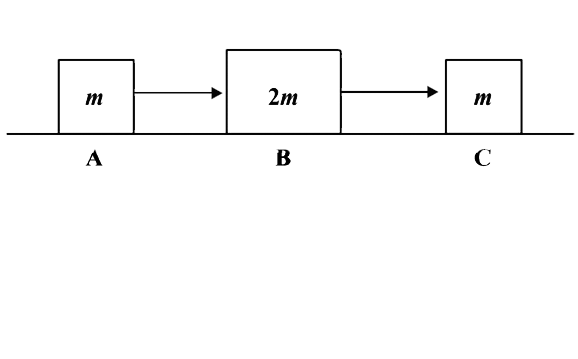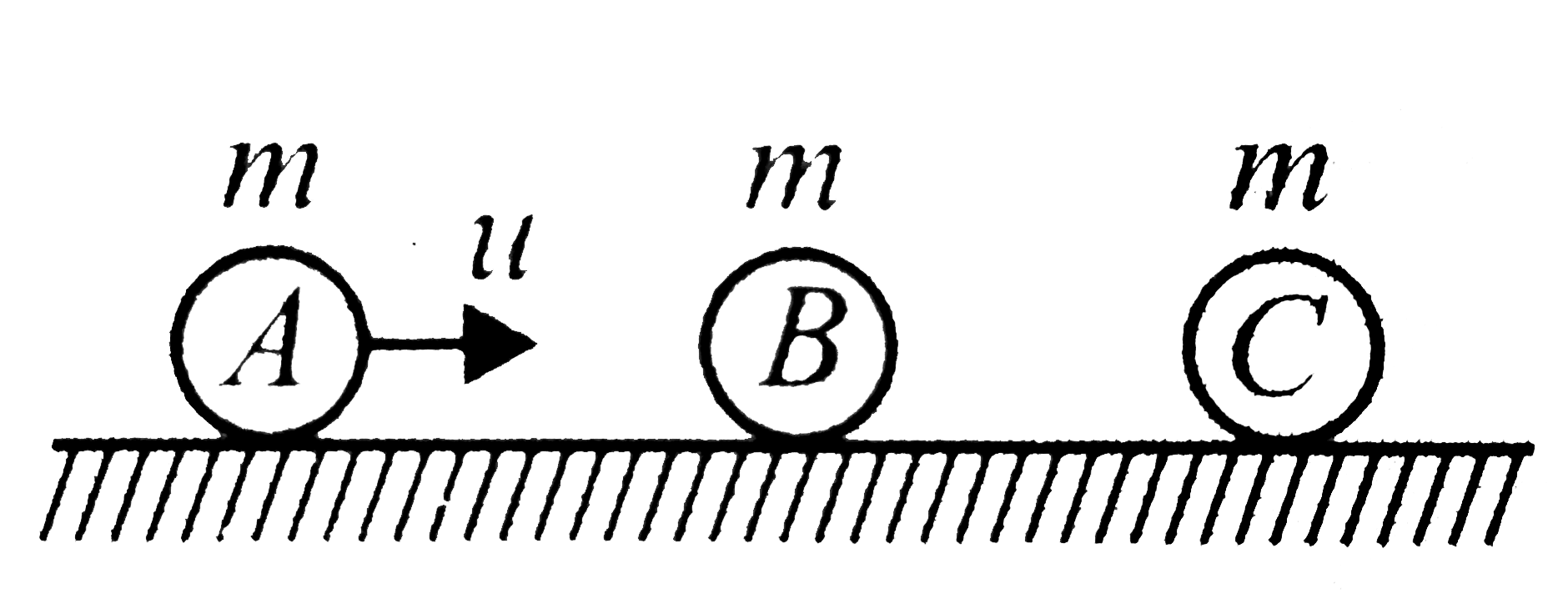There object A,B and C are kept is a straing line a frictionless horizontal surface . These have masses have increase on 2m and m respectively . The object A move toward B with a speed 9 m//s and makes as elastic collision with a there after B makes completely inclesis with C . All motion over on the same straight line . Find the first speed of the object C

The correct Answer is:4
After the first collision,
mvA=mv′A+2mv′B
1=v′B−v′AvA⇒v′B=6m/s
After the second collision,
2mv′B=(2m+m)vc⇒vC=(2/3)v′B⇒vC=4m/s

Topper's Solved these Questions
- BOOK - VMC MODULES ENGLISHCHAPTER - ENERGY & MOMENTUMEXERCISE - JEE ADVANCE (ARCHIVE) - PARAGRAPH QUESTIONS5videos
ENERGY & MOMENTUM
- BOOK - VMC MODULES ENGLISHCHAPTER - ENERGY & MOMENTUMEXERCISE - JEE ADVANCE (ARCHIVE) - ASSERTION & REASON TYPE1videos
ENERGY & MOMENTUM
- BOOK - VMC MODULES ENGLISHCHAPTER - ENERGY & MOMENTUMEXERCISE - JEE MAIN (ARCHIVE)53videos
ENERGY & MOMENTUM
- BOOK - VMC MODULES ENGLISHCHAPTER - ELECTROSTATICSEXERCISE - JEE Advanced (Archive)89videos
ELECTROSTATICS
- BOOK - VMC MODULES ENGLISHCHAPTER - GASEOUS STATE & THERMODYNAMICSEXERCISE - JEE ADVANCED (ARCHIVE )111videos
GASEOUS STATE & THERMODYNAMICS
Similar Questions
Three objects A ,B and C are kept in a straight line on a smooth horizontal surface. These have masses m, 2m and 3m , respectively . The head - on elastic collision takes place between A and B and then B makes completely inelastic collision with C. All motions occur on the same straight line. The final speed of C will be
 View Solution
View SolutionFour identical balls A,B,C and D are placed in a line on frictionless horizontal surface. A and D are moed with the same speed u towards the middle as shown. Assuming elastic collisions, find the final velocities.
 View Solution
View Solution
Knowledge Check
- Question 1 - Select One
Two blocks M1andM2 having equal masses are to move on a horizontal frictionless surface. M2 is attached to a massless spring as shown in figure. Initially M2 is at rest and M1 is moving toward M2 with speed v and collides head-on with M2.
 AWhile spring is fully compressed, all the kinetic energy of M1 is stored as potential energy of springBWhile spring is fully compressed, the system's momentum is not conserved, though final momentum is equal to initial momentum.CIf spring is massless, the final state of the M2 is state of rest.DIf the surface on which blocks are moving has friction, then collision cannot be elastic
AWhile spring is fully compressed, all the kinetic energy of M1 is stored as potential energy of springBWhile spring is fully compressed, the system's momentum is not conserved, though final momentum is equal to initial momentum.CIf spring is massless, the final state of the M2 is state of rest.DIf the surface on which blocks are moving has friction, then collision cannot be elastic
Three identical blocks A, B and C are placed on horizontal frictionless surface. The blocks B and C are at rest. But A is approaching towards B with a speed of 10ms−1

The coefficient of restitution for all collision is 0.5. The speed of the block C just after collision isView SolutionThree identical block A, B and C are placed on a horizontal frictionless surface. The blocks B and C are at rest but A is approaching towards B with a speed 10ms−1. The coefficient of restitution for all collisions is 0.5. The speed of the block C just after the collision is
 View Solution
View SolutionThree balls A,B and C of same mass m are placed on a frictionless horizontal plane in a straight line as shown. Ball A is moved with velocity u towards the middle ball B. If all the collisions are elastic, find the final velocities of all the balls.
 View Solution
View SolutionAn object of mass m1 moving with speed v collides with another object of mass m2 at rest and stick to it. Find the impulse imparted to the second object.
View SolutionA particle of mass m1, makes a head on elastic collision with another stationary body of mass m2 If m1, rebounds with half of its original speed then (m1m2) is
View SolutionTwo objects slide over a frictionless horizontal surface The first object, mass m1=5 kg, is propelled with a speed u=4.5m/s towards the second object, mass m2=2.5 kg while is intially at rest. After the collision, both objects have velocities which are directed at θ=30∘ on either side of the original line of motion of the first object. What are the final speed of the two object? Is the collision elastic or inelastic?
View SolutionA ball moving with a speed of 9ms−1 strikes an identical stationary ball such that after the collision the direction of each ball makes an angle of 30∘ with the original line of motion. The speeds of two balls after the collision is
View Solution

